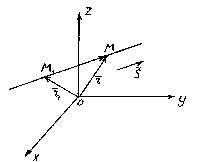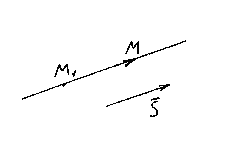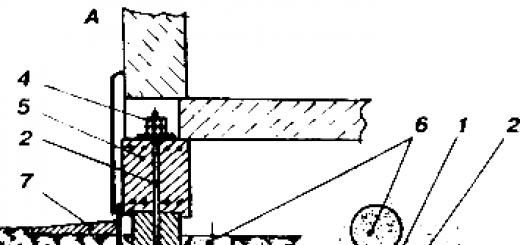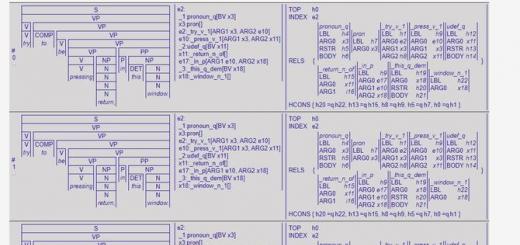Let two straight lines l and m on a plane in a Cartesian coordinate system be given by general equations: l: A 1 x + B 1 y + C 1 = 0, m: A 2 x + B 2 y + C 2 = 0
Normal vectors to these lines: = (A 1 , B 1) – to line l,
= (A 2 , B 2) – to line m.
Let j be the angle between lines l and m.


Since angles with mutually perpendicular sides are either equal or add up to p, then ![]() , that is, cos j = .
, that is, cos j = .
So, we have proven the following theorem.
Theorem. Let j be the angle between two lines on the plane, and let these lines be specified in the Cartesian coordinate system by the general equations A 1 x + B 1 y + C 1 = 0 and A 2 x + B 2 y + C 2 = 0. Then cos j =  .
.
Exercises.
1) Derive a formula for calculating the angle between straight lines if:
(1) both lines are specified parametrically; (2) both lines are given by canonical equations; (3) one line is specified parametrically, the other line is specified by a general equation; (4) both lines are given by an equation with an angular coefficient.
2) Let j be the angle between two straight lines on a plane, and let these straight lines be defined in a Cartesian coordinate system by the equations y = k 1 x + b 1 and y =k 2 x + b 2 .
Then tan j = .
3) Explore the relative position of two straight lines, given by general equations in the Cartesian coordinate system, and fill out the table:
The distance from a point to a straight line on a plane.
Let the straight line l on a plane in the Cartesian coordinate system be given by the general equation Ax + By + C = 0. Let us find the distance from the point M(x 0 , y 0) to the straight line l.
The distance from point M to straight line l is the length of the perpendicular HM (H О l, HM ^ l).

The vector and the normal vector to the line l are collinear, so | | = | | | | and | | = .
Let the coordinates of the point H be (x,y).
Since the point H belongs to the line l, then Ax + By + C = 0 (*).
Coordinates of vectors and: = (x 0 - x, y 0 - y), = (A, B).
| | = ![]() =
= ![]() =
=
(C = -Ax - By, see (*))
Theorem. Let the straight line l be specified in the Cartesian coordinate system by the general equation Ax + By + C = 0. Then the distance from the point M(x 0 , y 0) to this straight line is calculated by the formula: r (M; l) = .
Exercises.
1) Derive a formula for calculating the distance from a point to a line if: (1) the line is given parametrically; (2) the line is given to the canonical equations; (3) the straight line is given by an equation with an angular coefficient.
2) Write the equation of a circle tangent to the line 3x – y = 0, with center at point Q(-2,4).
3) Write the equations of the lines dividing the angles formed by the intersection of the lines 2x + y - 1 = 0 and x + y + 1 = 0, in half.
§ 27. Analytical definition of a plane in space
Definition. The normal vector to the plane we will call a non-zero vector, any representative of which is perpendicular to a given plane.
Comment. It is clear that if at least one representative of the vector is perpendicular to the plane, then all other representatives of the vector are perpendicular to this plane.
Let a Cartesian coordinate system be given in space.
Let a plane be given, = (A, B, C) – the normal vector to this plane, point M (x 0 , y 0 , z 0) belongs to plane a.

For any point N(x, y, z) of plane a, the vectors and are orthogonal, that is, their scalar product is equal to zero: = 0. Let us write the last equality in coordinates: A(x - x 0) + B(y - y 0) + C(z - z 0) = 0.
Let -Ax 0 - By 0 - Cz 0 = D, then Ax + By + Cz + D = 0.
Let us take a point K (x, y) such that Ax + By + Cz + D = 0. Since D = -Ax 0 - By 0 - Cz 0, then A(x - x 0) + B(y - y 0) + C(z - z 0) = 0. Since the coordinates of the directed segment = (x - x 0, y - y 0, z - z 0), the last equality means that ^, and, therefore, K О a.
So, we have proven the following theorem:
Theorem. Any plane in space in a Cartesian coordinate system can be specified by an equation of the form Ax + By + Cz + D = 0 (A 2 + B 2 + C 2 ≠ 0), where (A, B, C) are the coordinates of the normal vector to this plane.
The opposite is also true.
Theorem. Any equation of the form Ax + By + Cz + D = 0 (A 2 + B 2 + C 2 ≠ 0) in the Cartesian coordinate system specifies a certain plane, and (A, B, C) are the coordinates of the normal vector to this plane.
Proof.
Take a point M (x 0 , y 0 , z 0) such that Ax 0 + By 0 + Cz 0 + D = 0 and vector = (A, B, C) ( ≠ q).
A plane (and only one) passes through point M perpendicular to the vector. According to the previous theorem, this plane is given by the equation Ax + By + Cz + D = 0.
Definition. An equation of the form Ax + By + Cz + D = 0 (A 2 + B 2 + C 2 ≠ 0) is called general plane equation.
Example.
Let's write the equation of the plane passing through the points M (0,2,4), N (1,-1,0) and K (-1,0,5).
1. Find the coordinates of the normal vector to the plane (MNK). Since the vector product ´ is orthogonal to the non-collinear vectors and , then the vector is collinear ´ .
= (1, -3, -4), = (-1, -2, 1);
´ = (-11, 3, -5).
So, as the normal vector we take the vector = (-11, 3, -5).
2. Let us now use the results of the first theorem:
equation of this plane A(x - x 0) + B(y - y 0) + C(z - z 0) = 0, where (A, B, C) are the coordinates of the normal vector, (x 0 , y 0 , z 0) – coordinates of a point lying in the plane (for example, point M).
11(x - 0) + 3(y - 2) - 5(z - 4) = 0
11x + 3y – 5z + 14 = 0
Answer: -11x + 3y - 5z + 14 = 0.
Exercises.
1) Write the equation of the plane if
(1) the plane passes through the point M (-2,3,0) parallel to the plane 3x + y + z = 0;
(2) the plane contains the (Ox) axis and is perpendicular to the x + 2y – 5z + 7 = 0 plane.
2) Write the equation of the plane passing through the three given points.
§ 28. Analytical definition of a half-space*
Comment*. Let some plane be fixed. Under half-space we will understand the set of points lying on one side of a given plane, that is, two points lie in the same half-space if the segment connecting them does not intersect the given plane. This plane is called the border of this half-space. The union of this plane and half-space will be called closed half-space.
Let a Cartesian coordinate system be fixed in space.
Theorem. Let the plane a be given by the general equation Ax + By + Cz + D = 0. Then one of the two half-spaces into which the plane a divides the space is given by the inequality Ax + By + Cz + D > 0, and the second half-space is given by the inequality Ax + By + Cz + D< 0.
Proof.
Let us plot the normal vector = (A, B, C) to the plane a from the point M (x 0 , y 0 , z 0) lying on this plane: = , M О a, MN ^ a. The plane divides space into two half-spaces: b 1 and b 2. It is clear that point N belongs to one of these half-spaces. Without loss of generality, we will assume that N О b 1 .

Let us prove that the half-space b 1 is defined by the inequality Ax + By + Cz + D > 0.
1) Take a point K(x,y,z) in the half-space b 1 . Angle Ð NMK is the angle between the vectors and - acute, therefore the scalar product of these vectors is positive: > 0. Let us write this inequality in coordinates: A(x - x 0) + B(y - y 0) + C(z - z 0) > 0, that is, Ax + By + Cy - Ax 0 - By 0 - C z 0 > 0.
Since M О b 1, then Ax 0 + By 0 + C z 0 + D = 0, therefore -Ax 0 - By 0 - C z 0 = D. Therefore, the last inequality can be written as follows: Ax + By + Cz + D > 0.
2) Take a point L(x,y) such that Ax + By + Cz + D > 0.
Let's rewrite the inequality by replacing D with (-Ax 0 - By 0 - C z 0) (since M О b 1, then Ax 0 + By 0 + C z 0 + D = 0): A(x - x 0) + B(y - y 0) + C(z - z 0) > 0.
A vector with coordinates (x - x 0,y - y 0, z - z 0) is a vector, so the expression A(x - x 0) + B(y - y 0) + C(z - z 0) can be understood , as a scalar product of vectors and . Since the scalar product of vectors and is positive, the angle between them is acute and the point L О b 1 .
Similarly, we can prove that the half-space b 2 is given by the inequality Ax + By + Cz + D< 0.
Notes.
1) It is clear that the proof given above does not depend on the choice of point M in the plane a.
2) It is clear that the same half-space can be defined by different inequalities.
The opposite is also true.
Theorem. Any linear inequality of the form Ax + By + Cz + D > 0 (or Ax + By + Cz + D< 0) (A 2 + B 2 + C 2 ≠ 0) задает в пространстве в декартовой системе координат полупространство с границей Ax + By + Cz + D = 0.
Proof.
The equation Ax + By + Cz + D = 0 (A 2 + B 2 + C 2 ≠ 0) in space defines a certain plane a (see § ...). As was proven in the previous theorem, one of the two half-spaces into which the plane divides the space is given by the inequality Ax Ax + By + Cz + D > 0.
Notes.
1) It is clear that a closed half-space can be defined by a non-strict linear inequality, and any non-strict linear inequality in the Cartesian coordinate system defines a closed half-space.
2) Any convex polyhedron can be defined as the intersection of closed half-spaces (the boundaries of which are planes containing the faces of the polyhedron), that is, analytically - by a system of linear non-strict inequalities.
Exercises.
1) Prove the two theorems presented for an arbitrary affine coordinate system.
2) Is the converse true, that any system of non-strict linear inequalities defines a convex polygon?
Exercise.1) Investigate the relative positions of two planes defined by general equations in the Cartesian coordinate system and fill out the table.
Let straight lines be given in space l And m. Through some point A of space we draw straight lines l 1 || l And m 1 || m(Fig. 138).
Note that point A can be chosen arbitrarily; in particular, it can lie on one of these lines. If straight l And m intersect, then A can be taken as the point of intersection of these lines ( l 1 = l And m 1 = m).
Angle between non-parallel lines l And m is the value of the smallest of adjacent angles formed by intersecting lines l 1 And m 1 (l 1 || l, m 1 || m). The angle between parallel lines is considered equal to zero.
Angle between straight lines l And m denoted by \(\widehat((l;m))\). From the definition it follows that if it is measured in degrees, then 0° < \(\widehat((l;m)) \) < 90°, and if in radians, then 0 < \(\widehat((l;m)) \) < π / 2 .
Task. Given a cube ABCDA 1 B 1 C 1 D 1 (Fig. 139).

Find the angle between straight lines AB and DC 1.
Straight lines AB and DC 1 crossing. Since straight line DC is parallel to straight line AB, the angle between straight lines AB and DC 1, according to definition, is equal to \(\widehat(C_(1)DC)\).
Therefore, \(\widehat((AB;DC_1))\) = 45°.
Direct l And m are called perpendicular, if \(\widehat((l;m)) \) = π / 2. For example, in a cube
Calculation of the angle between straight lines.
The problem of calculating the angle between two straight lines in space is solved in the same way as in a plane. Let us denote by φ the magnitude of the angle between the lines l 1 And l 2, and through ψ - the magnitude of the angle between the direction vectors A And b these straight lines.

Then if
ψ <90° (рис. 206, а), то φ = ψ; если же ψ >90° (Fig. 206.6), then φ = 180° - ψ. Obviously, in both cases the equality cos φ = |cos ψ| is true. According to the formula (the cosine of the angle between non-zero vectors a and b is equal to the scalar product of these vectors divided by the product of their lengths) we have
$$ cos\psi = cos\widehat((a; b)) = \frac(a\cdot b)(|a|\cdot |b|) $$
hence,
$$ cos\phi = \frac(|a\cdot b|)(|a|\cdot |b|) $$
Let the lines be given by their canonical equations
$$ \frac(x-x_1)(a_1)=\frac(y-y_1)(a_2)=\frac(z-z_1)(a_3) \;\; And \;\; \frac(x-x_2)(b_1)=\frac(y-y_2)(b_2)=\frac(z-z_2)(b_3) $$
Then the angle φ between the lines is determined using the formula
$$ cos\phi = \frac(|a_(1)b_1+a_(2)b_2+a_(3)b_3|)(\sqrt((a_1)^2+(a_2)^2+(a_3)^2 )\sqrt((b_1)^2+(b_2)^2+(b_3)^2)) (1)$$
If one of the lines (or both) is given by non-canonical equations, then to calculate the angle you need to find the coordinates of the direction vectors of these lines, and then use formula (1).
Task 1. Calculate the angle between lines
$$ \frac(x+3)(-\sqrt2)=\frac(y)(\sqrt2)=\frac(z-7)(-2) \;\;and\;\; \frac(x)(\sqrt3)=\frac(y+1)(\sqrt3)=\frac(z-1)(\sqrt6) $$
Direction vectors of straight lines have coordinates:
a = (-√2 ; √2 ; -2), b = (√3 ; √3 ; √6 ).
Using formula (1) we find
$$ cos\phi = \frac(|-\sqrt6+\sqrt6-2\sqrt6|)(\sqrt(2+2+4)\sqrt(3+3+6))=\frac(2\sqrt6)( 2\sqrt2\cdot 2\sqrt3)=\frac(1)(2) $$
Therefore, the angle between these lines is 60°.
Task 2. Calculate the angle between lines
$$ \begin(cases)3x-12z+7=0\\x+y-3z-1=0\end(cases) and \begin(cases)4x-y+z=0\\y+z+1 =0\end(cases) $$
Behind the guide vector A On the first line we take the vector product of normal vectors n 1 = (3; 0; -12) and n 2 = (1; 1; -3) planes defining this line. Using the formula \(=\begin(vmatrix) i & j & k \\ x_1 & y_1 & z_1 \\ x_2 & y_2 & z_2 \end(vmatrix) \) we get
$$ a==\begin(vmatrix) i & j & k \\ 3 & 0 & -12 \\ 1 & 1 & -3 \end(vmatrix)=12i-3i+3k $$
Similarly, we find the direction vector of the second straight line:
$$ b=\begin(vmatrix) i & j & k \\ 4 & -1 & 1 \\ 0 & 1 & 1 \end(vmatrix)=-2i-4i+4k $$
But using formula (1) we calculate the cosine of the desired angle:
$$ cos\phi = \frac(|12\cdot (-2)-3(-4)+3\cdot 4|)(\sqrt(12^2+3^2+3^2)\sqrt(2 ^2+4^2+4^2))=0 $$
Therefore, the angle between these lines is 90°.
Task 3. In the triangular pyramid MABC, the edges MA, MB and MC are mutually perpendicular (Fig. 207);

their lengths are respectively 4, 3, 6. Point D is the middle [MA]. Find the angle φ between lines CA and DB.
Let CA and DB be the direction vectors of straight lines CA and DB.
Let's take point M as the origin of coordinates. By the condition of the equation we have A (4; 0; 0), B(0; 0; 3), C(0; 6; 0), D (2; 0; 0). Therefore \(\overrightarrow(CA)\) = (4; - 6;0), \(\overrightarrow(DB)\)= (-2; 0; 3). Let's use formula (1):
$$ cos\phi=\frac(|4\cdot (-2)+(-6)\cdot 0+0\cdot 3|)(\sqrt(16+36+0)\sqrt(4+0+9 )) $$
Using the cosine table, we find that the angle between straight lines CA and DB is approximately 72°.
It will be useful for every student who is preparing for the Unified State Exam in mathematics to repeat the topic “Finding an angle between straight lines.” As statistics show, when passing the certification test, tasks in this section of stereometry cause difficulties for a large number of students. At the same time, tasks that require finding the angle between straight lines are found in the Unified State Exam at both the basic and specialized levels. This means that everyone should be able to solve them.
Basic moments
There are 4 types of relative positions of lines in space. They can coincide, intersect, be parallel or intersecting. The angle between them can be acute or straight.
To find the angle between lines in the Unified State Exam or, for example, in solving, schoolchildren in Moscow and other cities can use several ways to solve problems in this section of stereometry. You can complete the task using classical constructions. To do this, it is worth learning the basic axioms and theorems of stereometry. The student needs to be able to reason logically and create drawings in order to bring the task to a planimetric problem.
You can also use the coordinate vector method using simple formulas, rules and algorithms. The main thing in this case is to perform all calculations correctly. The Shkolkovo educational project will help you hone your problem-solving skills in stereometry and other sections of the school course.
ANGLE BETWEEN PLANES
Consider two planes α 1 and α 2, defined respectively by the equations:

Under angle between two planes we will understand one of the dihedral angles formed by these planes. It is obvious that the angle between the normal vectors and planes α 1 and α 2 is equal to one of the indicated adjacent dihedral angles or ![]() . That's why
. That's why  . Because
. Because ![]() And
And ![]() , That
, That
 .
.
Example. Determine the angle between planes x+2y-3z+4=0 and 2 x+3y+z+8=0.
![]()
Condition for parallelism of two planes.
Two planes α 1 and α 2 are parallel if and only if their normal vectors are parallel, and therefore ![]() .
.
So, two planes are parallel to each other if and only if the coefficients of the corresponding coordinates are proportional:
![]() or
or
Condition of perpendicularity of planes.
It is clear that two planes are perpendicular if and only if their normal vectors are perpendicular, and therefore, or .
Thus, .
Examples.
STRAIGHT IN SPACE.
VECTOR EQUATION FOR A LINE.
PARAMETRIC DIRECT EQUATIONS

The position of a line in space is completely determined by specifying any of its fixed points M 1 and a vector parallel to this line.
A vector parallel to a line is called guides vector of this line.
So let the straight line l passes through a point M 1 (x 1 , y 1 , z 1), lying on a line parallel to the vector .
Consider an arbitrary point M(x,y,z) on a straight line. From the figure it is clear that ![]() .
.
Vectors and are collinear, so there is such a number t, what , where is the multiplier t can take any numeric value depending on the position of the point M on a straight line. Factor t called a parameter. Having designated the radius vectors of points M 1 and M respectively, through and , we obtain . This equation is called vector equation of a straight line. It shows that for each parameter value t corresponds to the radius vector of some point M, lying on a straight line.
Let's write this equation in coordinate form. Notice, that , ![]() and from here
and from here
The resulting equations are called parametric equations of a straight line.
When changing a parameter t coordinates change x, y And z and period M moves in a straight line.
CANONICAL EQUATIONS OF THE DIRECT

Let M 1 (x 1 , y 1 , z 1) – a point lying on a straight line l, And ![]() is its direction vector. Let us again take an arbitrary point on the line M(x,y,z) and consider the vector .
is its direction vector. Let us again take an arbitrary point on the line M(x,y,z) and consider the vector .
It is clear that the vectors are also collinear, so their corresponding coordinates must be proportional, therefore,
![]() – canonical equations of a straight line.
– canonical equations of a straight line.
Note 1. Note that the canonical equations of the line could be obtained from the parametric ones by eliminating the parameter t. Indeed, from the parametric equations we obtain ![]() or
or ![]() .
.
Example. Write down the equation of the line ![]() in parametric form.
in parametric form.
Let's denote ![]() , from here x = 2 + 3t, y = –1 + 2t, z = 1 –t.
, from here x = 2 + 3t, y = –1 + 2t, z = 1 –t.
Note 2. Let the straight line be perpendicular to one of the coordinate axes, for example the axis Ox. Then the direction vector of the line is perpendicular Ox, hence, m=0. Consequently, the parametric equations of the line will take the form
Excluding the parameter from the equations t, we obtain the equations of the line in the form

However, in this case too, we agree to formally write the canonical equations of the line in the form ![]() . Thus, if the denominator of one of the fractions is zero, this means that the straight line is perpendicular to the corresponding coordinate axis.
. Thus, if the denominator of one of the fractions is zero, this means that the straight line is perpendicular to the corresponding coordinate axis.
Similar to the canonical equations ![]() corresponds to a straight line perpendicular to the axes Ox And Oy or parallel to the axis Oz.
corresponds to a straight line perpendicular to the axes Ox And Oy or parallel to the axis Oz.
Examples.
GENERAL EQUATIONS OF A STRAIGHT LINE AS LINES OF INTERSECTION OF TWO PLANES
Through every straight line in space there are countless planes. Any two of them, intersecting, define it in space. Consequently, the equations of any two such planes, considered together, represent the equations of this line.
In general, any two non-parallel planes given by the general equations

determine the straight line of their intersection. These equations are called general equations straight.
Examples.
Construct a line given by the equations ![]()

To construct a straight line, it is enough to find any two of its points. The easiest way is to select the points of intersection of a straight line with coordinate planes. For example, the point of intersection with the plane xOy we obtain from the equations of the straight line, assuming z= 0:
Having solved this system, we find the point M 1 (1;2;0).
Similarly, assuming y= 0, we get the point of intersection of the line with the plane xOz:
![]()

From the general equations of a straight line one can move on to its canonical or parametric equations. To do this you need to find some point M 1 on a straight line and the direction vector of a straight line.
Point coordinates M 1 we obtain from this system of equations, giving one of the coordinates an arbitrary value. To find the direction vector, note that this vector must be perpendicular to both normal vectors ![]() And
And ![]() . Therefore, beyond the direction vector of the straight line l you can take the vector product of normal vectors:
. Therefore, beyond the direction vector of the straight line l you can take the vector product of normal vectors:
 .
.
Example. Give general equations of the line ![]() to the canonical form.
to the canonical form.
Let's find a point lying on a line. To do this, we choose arbitrarily one of the coordinates, for example, y= 0 and solve the system of equations:
![]()
The normal vectors of the planes defining the line have coordinates ![]() Therefore, the direction vector will be straight
Therefore, the direction vector will be straight
 . Hence, l:
. Hence, l: ![]() .
.
ANGLE BETWEEN STRAIGHTS
Angle between straight lines in space we will call any of the adjacent angles formed by two straight lines drawn through an arbitrary point parallel to the data.
Let two lines be given in space:
Obviously, the angle φ between straight lines can be taken as the angle between their direction vectors and . Since , then using the formula for the cosine of the angle between vectors we get










